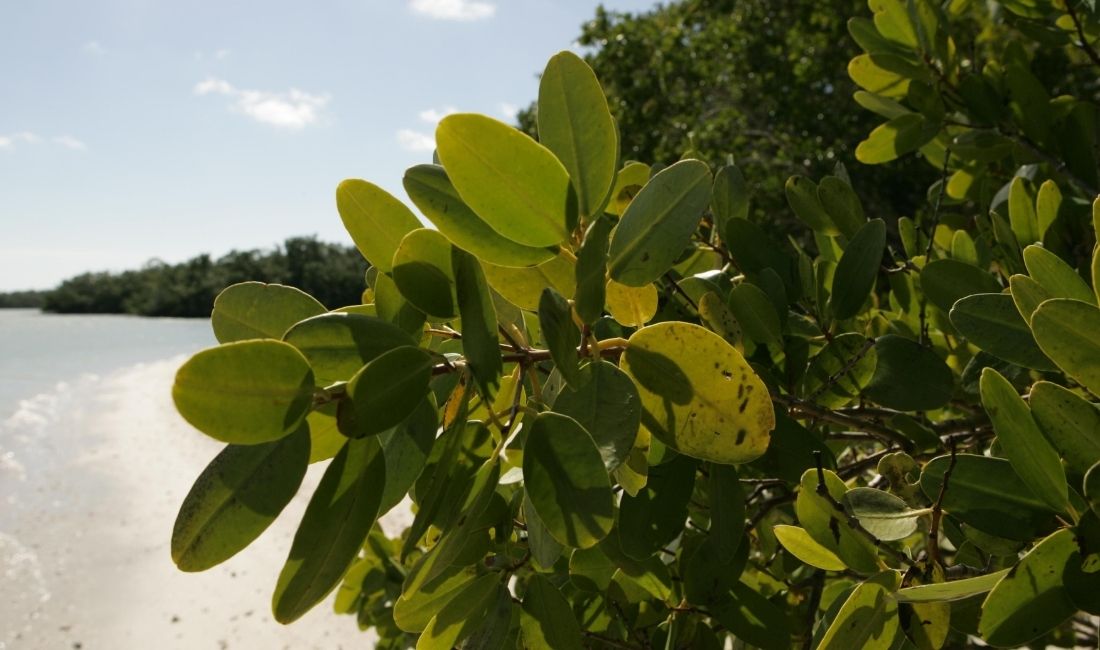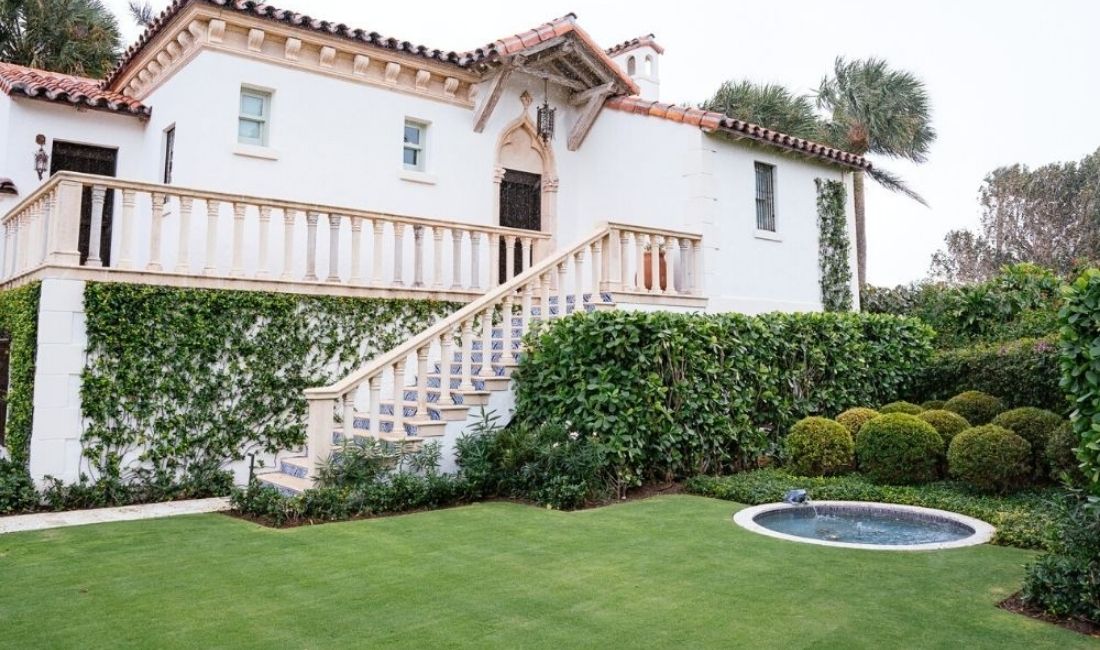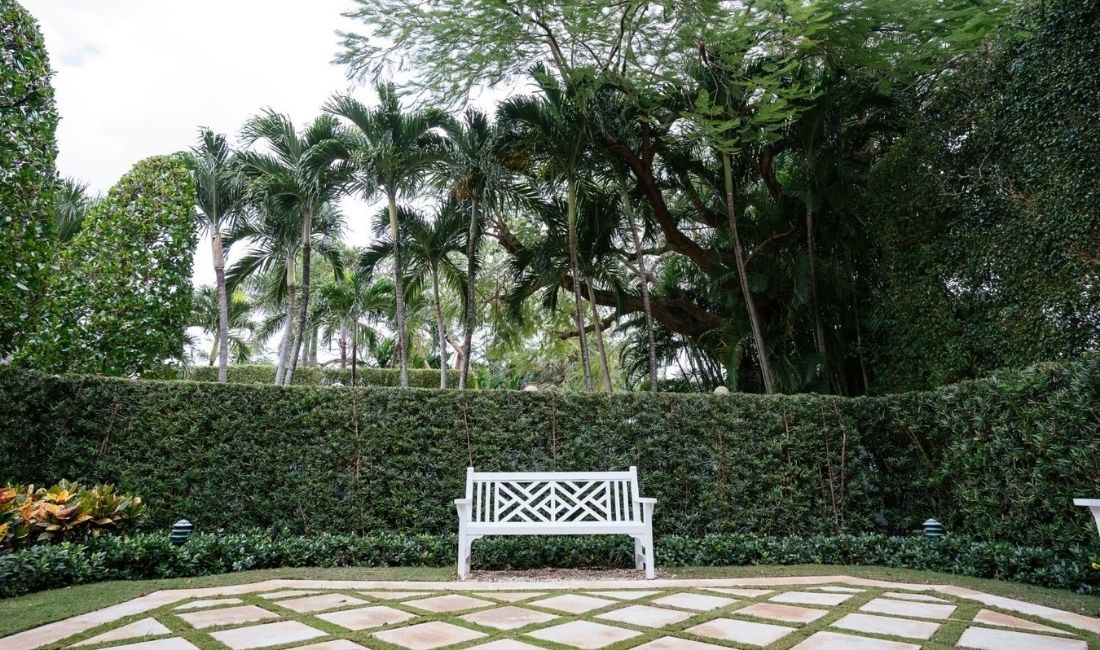Hurricane season in Palm Beach officially runs from June 1 until November 30. But we all know that storms can hit the island at any time of year. So how do you keep your beachfront property looking good through all weather events and seasons? Make sure your landscape is designed, installed, and maintained with these storm-resistant principles in mind.
Storm-Related Problems for Beachfront Properties
Palm Beach island is a wonderful place to live but it does come with a few challenges, particularly for landscapes. Strong winds, storm surge, heavy rain, and hurricanes can all wreak havoc on trees, landscape plants, hardscaping, and even your home. Common problems include:
- Ocean spray and wind-borne salt spray can quickly kill plants
- Saltwater corrosion on hardscaping, metalwork, and structures
- Flooding from heavy rains or storm surge
- Wind damage that can shred plant leaves, break branches, topple trees, and shatter or destroy structures as
- Erosion from high waves, flooding, heavy rain, and storm surge
- Sand blowing in from the beach, which can bury smaller plants and cause chipping, scratching, and rusting on metalwork and other finishes

While Norfolk Island Pines grow well in New Zealand (shown above), they do not do well in the severe storms and hurricanes in South Florida.
Benefits of Storm-Tolerant Landscapes
The obvious benefit of a landscape that can handle heavy weather with aplomb is the lower cost of landscape cleanup after a storm. Storm-resistant landscapes come through weather events with:
- fewer broken limbs on trees and shrubs,
- less damage to leaves from wind and storm-driven salt,
- less erosion, and
- fewer plants that need to be replaced.
But a hurricane-resistant landscape also offers Palm Beach residents some other benefits.
- Plants and hardscaping that can tolerate hurricanes also tend to have lower maintenance needs.
- When properly designed to withstand storms, a well-maintained landscape can protect your home. Trees, especially, can create a windbreak to lessen the effect of wind gusts. And, when properly planted and cared for, trees planted in groups are much more likely to survive a storm relatively unscathed.
How to Create a Hurricane-Resistant Landscape
Working with a landscape designer and knowledgeable landscape contractor is the best way to ensure that your beachfront landscape will withstand storms and hurricanes without significant damage. Together, these professionals will help you choose and install the best plants and materials to keep your property safe and beautiful.
Below are some of the things they’ll consider when creating your landscape.

Crape myrtles tend to do well in hurricane-prone environments such as Palm Beach.
Plant Hurricane-Resistant Trees
Landscapes that have well-maintained, healthy trees fare better in hurricanes and tropical storms, as do properties planted with hurricane-resistant trees.
Below are recommended trees that are least likely to lose limbs, break apart, or fall over during hurricanes in South Florida.
- Sand live oak (Quercus geminata)
- American holly (Ilex opaca)
- Southern magnolia (Magnolia grandiflora)
- Live oak (Quercus virginiana) – See our article on planting and growing live oak in South Florida
- Wax myrtle (Myrica cerifera)
- Sweetgum (Liquidambar styraciflua)
- Crape myrtle (Lagerstroemia indica)
- Dogwood (Cornus florida)
- Sabal Palm (Sabal palmetto) – See our article on palm trimming to prevent hurricane damage
Remove Trees That Are Susceptible to Storm Damage
According to the South Florida Water Management District’s guidance on Storm Wise landscapes, some tree species perform so poorly in storms that you should carefully reconsider whether or not you want them in your landscape. If any of the species listed below are already a part of your landscape, you may want to consider removing them and replacing them with something that is storm-hardy.
- Australian Pine (Casuarina spp.)
- Yellow Tabebuia (Tabebuia caraiba)
- Norfolk Island Pine (Araucaria heterophylla)
- Black Olive (Bucida buceras)
- Weeping Fig (Ficus benjamina)
- Queen Palm (Syagrus romanoffzianum)
- Carrotwood (Cupaniopsis anacardioides)
- Royal Poinciana (Delonix regia)
- Silk Oak (Grevillea robusta)
- Java Plum (Syzygium cumini)
- Hong Kong Orchid (Bauhinia variegate)
- Jacaranda (Jacaranda mimosifolia)
- Earleaf Acacia (Acacia auriculiformis)
- Eucalyptus (Eucalyptus camaldulensis)
- Javanese Bishopwood (Bischofia javanica)
- Washington Fan Palm (Washingtonia robusta)

Red mangrove is a salt-resistant plant that does well in areas close to the ocean.
Select Salt-Resistant Plants
When you live near the ocean (that means within about 1/8 mile), it’s important to select plants that can tolerate (or even thrive in) salty conditions, as well as the parched, sandy, and nutrient-deficient soils usually found along the coastline. Healthy trees, shrubs, and landscape plants not only make your property look better, but they also provide some important benefits for beachfront landscapes. For example:
- Healthy root systems structurally reinforce and support slopes (similar to rebar reinforcing concrete in building construction), slowing erosion. They also bind soil particles and reduce their susceptibility to erosion from wind or rain.
- Plants take up water directly from the ground, absorb it through their leaves, and break the impact of raindrops or wave-splash. As a result, plants slow down the rate and quantity of water runoff that can lead to erosion.
Salt spray can burn leaves on all trees, but some species are more susceptible than others. Pines and other evergreens are particularly vulnerable to salt injury.
The best way to avoid the heartbreak of salt injury in your landscape is to choose resilient species.
Trees in South Florida that are most tolerant of salt (both in the soil, such as from flooding, and wind-borne salt spray) include:
- Our state’s iconic live oak (Querus virginiana)
- Southern Red Cedar (Juniperus virginiana var silicicola)
- Japanese Red Pine (Pinus thunbergia)
- Redbay (Persea borbonia)
- Florida Soapberry (Sapindus saponaria)
- Mangroves: Red mangrove (Rhizophora mangle), black mangrove (Avicennia germinans), and white mangrove (Laguncularia racemose).
Some common palms are also salt-tolerant, including:
- Cabbage palm (Sabal palmetto)
- Saw palmetto (Serenoa repens)
- Washington or fan palm (Washingtonia robusta)
We also share some wonderful flowering and hardy shrubs and trees that can tolerate the extremes of coastal landscapes in this article – 5 Best Plants for Coastal Landscapes.
Not only will these trees stand up to salt, but most require less maintenance and are drought resistant. If your Palm Beach home doesn’t see use (or maintenance) year-round, low-maintenance plants are a must!
Plan Ahead to Reduce Erosion
Homes built near the ocean are susceptible to erosion from storm surge and flooding. However, there are ways to help prevent your property from washing away or putting your home at risk.
If erosion is a problem on your property, consider planting a buffer area of native trees, shrubs, and deep-rooted grasses between the maintained areas of your property and the shore. This can help stop or slow shoreline erosion, filter sediments, and pollutants before they’re discharged into the ocean, and can be a beautiful addition to your view.
An experienced landscape contractor and/or landscape designer can help you select a combination of hardy native plants that will look beautiful while helping stabilize the soil. And when you add carefully placed retaining walls, terraces, and other landscaping features to help control water flow on your property, it will further reduce the risk of soil erosion.

Choose the Right Lawn Grass
Not all turfgrass or grasses used in lawns can tolerate salt exposure.
For coastal lawns, the University of Florida recommends several types of salt-tolerant turfgrass, including St. Augustinegrass and zoysia. While they can’t be irrigated with saltwater, they can handle some salt spray.
Another option is seashore paspalum. This deep green grass has excellent salt tolerance and thrives in heat. However, it’s a very high-maintenance grass that’s best used for areas of your property that are “wilder” or less manicured.
Be Careful Where You Plant Trees
Many properties have beautiful, large trees shading the house from sunlight, planted along the driveway, or screening private family spaces from view.
But when a tree falls during (or even after) a storm, it can cause far more damage than just destroying whatever it lands on. When a tree’s roots pull out of the soil, anything in the root zone or nearby will be pulled out as well. Underground utility lines, plumbing, and irrigation lines, fencing, retaining walls, nearby paved areas, and even your home’s foundation can be seriously damaged.
Work with a landscape designer or architect to carefully plan where to place trees on your property. Ensure that they aren’t planted over utility lines or too close to your home’s foundation. And always make sure that each tree has enough surrounding soil volume to develop a deep, strong root system. Trees with small, shallow, or confined roots are the most likely to topple during heavy rain or high winds.
Keep Roots Healthy
Roots don’t just absorb water and nutrients to feed trees and shrubs, they also anchor the plants firmly to the ground. Weak, shallow, rotting, or damaged roots make trees more likely to topple in storms, especially if the soil is saturated.
Water trees regularly when they’re getting established but, after that, water slowly, deeply, and only when needed. Hold off on fertilizer unless soil tests indicate it’s necessary. And avoid cutting tree roots during construction projects (such as installing a swimming pool or patio), as it will de-stabilize the tree when winds pick up.

Inspect & Prune Trees & Shrubs Regularly
Mature trees and palms usually represent the largest investment in your living landscape. They’re also the most common cause of serious storm damage to homes, particularly on oceanfront properties.
Trees in Palm Beach should be inspected and pruned by early June to ensure that they’re ready for the upcoming storm season. Routine tree and shrub trimming, as well as removing dead or broken branches, will also help landscapes survive major storms with less damage.
Use the Right Mulch
Ground-covering mulch is often an afterthought or is chosen purely from an aesthetic design perspective. But in areas exposed to ocean winds and heavy rain, it’s critical to choose the right landscape mulch.
For example, pea gravel or crushed shells make a beautiful mulch that complements the beachside location of many Palm Beach properties. But when winds pick up, those small pebbles can quickly become destructive projectiles, damaging windows, cars, outdoor furniture, and more.
Choose soft, organic mulches for coastal properties. Shredded wood, bark chips, and wood chips make an excellent mulch that looks attractive. These types of mulch also help improve the soil and encourage healthier plants. And while organic mulch does need to be regularly replenished, it’s otherwise low maintenance.
It’s far easier to scoop soft bark mulch out of the pool now and then than it is to replace all your home’s windows that overlook the beach.
Hire Beachfront Landscape Experts
Your beachfront property deserves the care and expertise of Palm Beach’s beachfront landscape professionals. The team at Coastal Gardens Professionals includes landscape designers, horticulturists, and estate gardeners with years of experience designing, installing, maintaining, and repairing fine properties on Palm Beach island.
CALL US TODAY At 561-308-7604
Estate landscape Services
For Fine Properties in Palm Beach
With Coastal Gardens, you can rest easy knowing that your property is taken care of by a dedicated team of estate landscape professionals who truly care about creating and maintaining a dazzling outdoor space you can be proud of.
